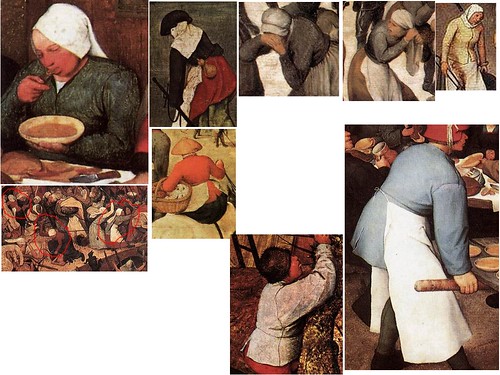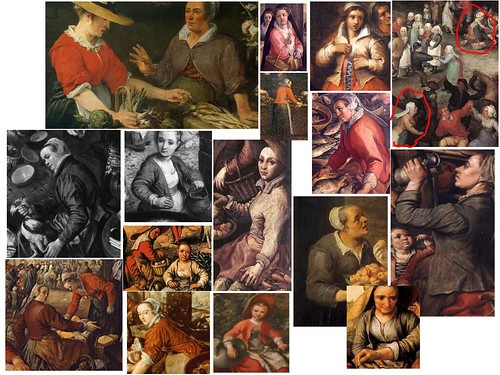I have been looking at jackets lately. I have also been looking at doublets, but I’ve decided, I want to make a jacket; the main difference being (as far as I can tell) is that the jacket is much less structured, with less interfacing than a doublet, no buttons up the front and certainly not so much in the way of slashes, poofs, pinking, and fancy construction. And while the general look of the jacket’s top half might look similar to a doublet, anything past the hips is quite different. A doublet tends to end right at the true waist, often in a point at the front, with some sort of skirting/tabs attached after that. The Tailor is a very good example of what I think of when I think ‘doublet’ : http://www.wga.hu/frames-e.html?/html/m/m
A doublet is not what I want to make.
I want to make a lower/middle class simple wool jacket to wear with my various working-class late period dresses. I kinda have several thoughts on this, and am trying to make sense of it all. I’m asking your opinion on what might be feasible based on some images I have.
http://www.artic.edu/aic/collections/art
So here is a simple-ish jacket, that is basicly the style I want to make, minus all of the fancy embroidery. It has a little collar, epaulets/shoulder bits, and triangle shaped gores for the hips. I think that this would look lovely as a wool working class jacket.
http://www.kipar.org/baroque-costumes/ph
Here is another even simpler jacket, again, try to ignore all the embroidery. Attack Laurel made an embroidered version of this jacket, and wrote about the process here http://www.extremecostuming.com/reproduc
Her jacket is lovely, and very documentable: just take a look at Larsdatter’s page on these jackets to see many examples of similar styles http://www.larsdatter.com/jackets.htm.
Now, these late period jackets are all well, good, and fine, but they are not quite what I want. They are too fancy. Too time consuming. And as far as I can tell, a little too upper class in appearence for what I want. So my next mission was to try and find images of working class versions of these jackets.
Here, in paintings by Aertsen and Beuckelaer(above) are most of the available images of this type of jacket being worn by Flemish women. It definately does not look like a doublet, I cant really see any sort of waist seam like a doublet would have, but I also don’t see any gores in the hip area like I was hoping for. That doesn’t mean that these jackets didn’t have any gores, just that I cant really see any. I feel pretty confident that these garments could be convincingly made with the Maidstone jacket pattern.
And below are images from another Flemish painter, Bruegel. All of three of these artists painted around the same time, 1560ish, but in different cities. The ‘jackets’ below most likely have waist seams, which was not what I wanted to find. Boo. And even though the two sets of images above and below are clearly not quite the same style of dress, I hesitate to think that the ‘jackets’ above might be any different from those below. The men in the bottom right are obviously not women, but I think that they help show what the female garments might be like, since they are not as clearly shown.

Also, look at this detail of a 1608 painting by one of Bruegel’s children: http://en.wikipedia.org/wiki/File:Pieter
The bottom part is of course covered by her skirt, but nifty image anyways.
So, going back to the Larsdatter page, this jacket style extends into the early 17th century. While I wanted to try to stick to pre-1600 for SCA purposes, I guess it wouldn’t hurt to specificly search for Jacobean peasant fashion.
On that note, look at this sexiness: http://americanduchess.blogspot.com/2010/0
More post period links, mostly about 1650: http://freespace.virgin.net/f.lea/jacket
Reconstructing History has a version of this jacket http://www.reconstructinghistory.com/pro
And while I have your attention, take a quick look at some of the Campi Italian working class dresses: http://www.festiveattyre.com/research/wk
So…. I guess what I am saying is this: I really want to make a plain colored, non embroidered, wool version of either this http://www.artic.edu/aic/collections/art
http://www.kipar.org/baroque-costumes/ph
Could I conceivably wear it with a Flemish, English, or Italian working class dress, and not have it look odd? With the bodice part covered, all of these styles of dress essentially look the same, since really a skirt is just a skirt. What might make them look distinctly Flemish vs. Italian would be the accessories and hairstyles I use.





